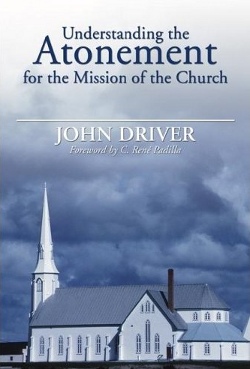Here’s an article from “Faith Stories”, a multimedia course on evangelism I’ve been preparing with Graham Beattie, Peter Armstrong and Jason Bray, due out in the next month. It’s designed to broaden our understanding of the gospel, to recognise that the “Christian gospel” is much broader and more significant than we have ever dreamed of.
How do you begin to explain the good news about Jesus to someone? What are the entry points through which people connect with the life, death, resurrection and ongoing life of Jesus today.
One way of describing “entry points” is imagining that the cross is surrounded by a wall with a number of gates or doors. Over time a person has the opportunity to walk around and see the cross from different perspectives.
Someone may first starting following Jesus, taking his lead as a servant, before discovering a reassurance of forgiveness of sin. At what point is that person a Christian, a disciple of Jesus? Does it matter? What does matter is that we help people access the good news of Jesus without requiring them first to adopt our interpretation of the cross.
- The Forgiveness Gate speaks of the new relationship we have with God when we accept that the death of Christ has dealt with the impact of our sin. God doesn’t treat us according to a list of our virtues and faults. Instead God regards us with grace, undeserved mercy. There is nothing we can do to earn that unconditional love. Romans outlines this approach to the life, death and resurrection of Jesus, reminding us that God’s acceptance is received through an attitude of trust in Jesus.
- The Release Gate speaks of Christ bringing freedom to the captives. Colossians 2.15 says that Christ defeated all powers and forces, letting the whole world see them being led away as prisoners when he celebrated his victory. For an example from the life of Jesus see the story of the man with many spirits (Legion) in Mark 5.1-20. People who are struggling with issues of sin, addiction and the power of evil, (personal or corporate) may find this gate relevant to them.
- The Cleansing Gate takes the sense of forgiveness and goes deeper, dealing with a sense of uncleanness or shame. The Jewish scriptures include actions of animal sacrifices that symbolize the removal of uncleanness. 1 John 1:7 to 2:2 introduces us to the symbolic offering of Jesus as a way of dealing with sin and shame. Another more accessible symbol of cleansing is baptism, as expressed in 1 Peter 3. 20-21. Perhaps the most powerful stories of cleansing from the gospels would be Jesus’ interactions with lepers, people whose skin diseases led to them being shunned as “unclean”. Those struggling with shame and rejection can find in Jesus the chance for a new start, a clean page to begin again.
- The Suffering Gate focuses on Christ’s suffering for us, and meeting us in our times of suffering. 1 Peter 2.21-25 talks about Christ setting an example by suffering for us. Mark 5.24-34 illustrates Jesus bringing healing for a sick woman. In John 11 we read about Jesus grieving with those who were lamenting the death of Lazarus. It’s through this gate that people who are experiencing personal suffering in their lives may first connect with Jesus.
- The Leadership Gate holds Jesus out to us as a representative person, pioneer, forerunner, leader and firstborn, as 1 Corinthians 15.20-22 teaches. Luke 7.1-10 gives us the story of a centurion (Roman officer soldier) who is inspired by Jesus’ capacity to lead. People who have a calling in terms of leadership may identify with this image of Christ.
- The Courage Gate reminds us of how Jesus laid down his life for us, as Jesus says in John 15.13. Revelation 12.11 shows people who were given courage to give up their lives, inspired by the sacrificial death of Jesus. For those who are fearful for their lives in a violent society the martyr-witness picture of Revelation 1.5-6 can show them how to live with courage in the face of violence – and even to die for their faith.
- The Change Gate connects our new Christian life with the life, death and resurrection of Jesus. Zaccheus, according to Luke 19: 1-10, was transformed by his meeting with Jesus, in a way that changed the lives of those around him. Romans 12:1-2 reminds us that we are to go on being transformed. Our experience of God in Jesus can give us new goals, new hopes, and new dreams, helping us transform the world around us, praying “Your Kingdom come, on Earth as in Heaven”
- The Service Gate captures the life of service we owe to the One who purchased us from the slave-market of sin, as Galatians 4.5 teaches. Philemon gives a practical example of a slave who was learning what it meant to be a follower of Jesus. The earliest creed of the early Christian community was “Jesus is Lord”. The life, death and resurrection of Jesus shows us the true nature of religion – service! See also James 1:27 and Isaiah 58 for what constitutes real religion – the religion God approves of. The Service Gate may be good news for people who are searching for purpose, direction, calling, and affirmation of their commitment to serving others.
- The Reconciliation Gate reminds us of how God turns his enemies into friends – as Colossians 1.20-22 teaches. Don Richardson, a Canadian missionary, found that the Sawi people of Irian Jaya responded to Jesus as the sacrificial peacemaker, because of their custom of “peace child”, in which warring chiefs would exchange their sons as “peace child”. Jesus lived this out in his life as he crossed boundaries to make friends with people who had been excluded as outsiders. The early Church discovered the good news that following Jesus was available to people from different cultures. Christ has broken down every wall, says the writer of Ephesians. People struggling with broken relationships, or who feel alienated from God, may find this aspect of the cross the most powerful to begin with.
- The Belonging Gate focuses on the wonderful family privileges we now enjoy through the life, death and resurrection of Christ. Galatians 4.3-7 reminds us that we have been adopted as God’s children. The parable of the prodigal son, told in Luke 15.11-22, reminds us that even if we have wandered far from God, we are welcomed back into God’s family. This is the gate most attractive to people who long for a sense of belonging, community and acceptance. It’s the gate that means the most when it is backed up by a loving Christian community.
There are many other gates of the cross found in the New Testament and through the life of the Church today. For example we could talk about the Truth Gate, remembering that Jesus talked about being the Way, The Truth, and The Life. We could talk about the Eternity gate, used throughout the Gospel of John, in which Jesus introduces us to everlasting life that begins now.
We have traditionally emphasised that “it is by grace that we are saved, through faith in Jesus Christ”. That certainly applies to the forgiveness gate, although Jesus did teach us to pray, “Forgive us our sins as we forgive those who sin against us Each of these ways of connecting with the life of Jesus is a gift that inspires and calls for a personal response.
Which of the above gates was the one that you first related to in your experience of Jesus? Through which gate are you now relating to him?
Which other gates can you identify that are not in the list here?
Some Christians identify the moment of becoming a Christian with the “sinner’s prayer” a prayer expressing trust in the forgiveness shown in Jesus. If we take seriously that people enter a life-long journey with Jesus through many entry points, we need to find other prayers as well. What would they be called? The forgiver’s prayer? The prayer of an advocate for justice? The prayer of the suffering? The peacemaker’s prayer? What would they include?
Understanding the Atonement for the Mission of the Church
 Credits for this work go to Gordon Miller, who published the 10 Gates to the Cross a number of times in his Leadership Letter when he was Churches Liaison Officer for World Vision New Zealand. Gordon drew heavily on the work of John Driver, as expressed in his book Understanding the Atonement for the Mission of the Church, originally published in 1987 and republished in 2005. See my earlier post on this subject, March 24, 2005.
Credits for this work go to Gordon Miller, who published the 10 Gates to the Cross a number of times in his Leadership Letter when he was Churches Liaison Officer for World Vision New Zealand. Gordon drew heavily on the work of John Driver, as expressed in his book Understanding the Atonement for the Mission of the Church, originally published in 1987 and republished in 2005. See my earlier post on this subject, March 24, 2005.
Here’s the publisher’s introduction to the book…
At the very center of the Christian faith is Jesus, a crucified Messiah. All the wisdom and the power of God have been revealed in him. Apart from such wisdom and power no genuine Christian experience is possible.
Unfortunately, Western Christianity has been so conditioned by Constantinian presuppositions that it has failed to take into account the centrality of the crucified Messiah. It has been far more preoccupied with worldly wisdom and worldly power than with faithfulness to the gospel of the kingdom. It has concentrated on the salvation of the individual soul but has frequently disregarded God’s purpose to create a new humanity marked by sacrificial love and justice for the poor.
In the classical theories on the atonement, the work of Christ was unrelated to God’s intention to create a new humanity. Driver here demonstrates that the covenanted community of God’s people is the essential context for understanding the atonement. The reconciling work of Christ creates a reconciling community where all the barriers that divide humankind break down.
Driver’s book is an invitation to look at the cross, not merely as the source of individual salvation, but as the place wherein begins the renewal of the creation — the new heavens and the new earth that God has promised and that the messianic community anticipates.


Hi Duncan
Was googling trying to source those 10 gates from Gordon Miller, so this is helpful, thanks. I’m embarking on a Masters and am keen to see which of these “gates” feature in people’s “conversion” stories.
(Also, happily, due to most excellent cataloging of steve’s books i can see (from my spreadsheet here) that he already has the Driver book… nice all my hard work is paying dividends to me :))
Lynne
Where can Gordon Miller’s leadership letters be accessed. I am trying to track down newsletters 169 and 170. Thanks.